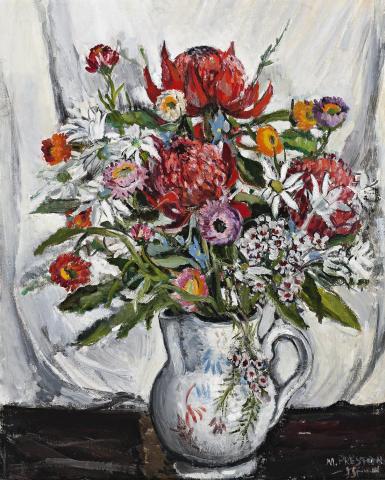FLOWERS IN A JUG, 1955
MARGARET PRESTON
oil on canvas
53.5 x 43.5 cm
signed and dated lower right: M. PRESTON / 55
Mr and Mrs I. Morris, South Australia by 1980
Peter Walker Fine Art, Adelaide
Private collection, Perth, acquired from the above in 2008
probably: Royal South Australian Society of Arts, Sydney painting 1955 (from Macquarie Galleries), Institute Building, Adelaide, 9 – 20 August 1955, cat. 44
The Art of Margaret Preston, Art Gallery of South Australia, Adelaide, 1980 and touring, cat. 45 (as ‘Mixed Flowers in a White Vase’)
North, I. (ed.), The Art of Margaret Preston, exhibition catalogue, Art Gallery of South Australia, Adelaide, 1980, cat. 0.45, p. 51 (illus. as ‘Mixed Flowers in a White Vase’)
Margaret Preston Catalogue Raisonné of paintings, monotypes and ceramics, Art Gallery of New South Wales, Sydney, 2005, CD-ROM compiled by Mimmocchi, D., with Edwards, D., and Peel, R.
In the catalogue of his 1980 pioneering retrospective exhibition of the paintings and prints of Margaret Preston at the Art Gallery of South Australia, curator Ian North commented: ‘The bulk of Preston’s later paintings were of still-life subjects, in which she reverted again to a more naturalistic style, demonstrating from time to time (e.g. in Mixed Flowers in a White Vase [our painting], 1955) a pungency and flair remarkable in any artist and especially one of her advanced years’.1 The striking individuality of her modernist still life paintings of the 1920s such as Implement Blue, 1927 and Western Australian Gum Blossoms, 1928 (both in the collection of the Art Gallery of New South Wales, Sydney), and Aboriginal Flowers, 1928, (Art Gallery of South Australia, Adelaide), echoed in her hand-coloured woodcuts of the same time, and today they are still hailed as among her finest works. Grand as they undoubtedly are, they tend, unfairly I believe, to put others too much in the shade, especially those of a more traditional inclination. While boldness of colour and design are the hallmarks of Preston’s art, there are additional qualities deserving admiration in an oeuvre outstanding for its originality and search for the quintessentially Australian.
Her contemporary, Thea Proctor wrote of Preston in 1927, ‘…we have a distinguished and original artist in Australia – an artist with abundant vitality … the intellectual gift of invention and an emotional colour sense which amounts to genius’.2 And that same year Sydney Ure Smith wrote in an editorial for Art in Australia: ‘All vital artists have enemies. Where they fail to inspire delight they instil terror. Margaret Preston is the natural enemy of the dull’.3 Throughout her life and her art she remained ‘the enemy of the dull’ in an output in which the avant-garde and the more naturalistic happily co-existed, both enriched by forthrightness and passion. Occasionally they combined, as in Monstera Deliciosa, 1934 (Bendigo Art Gallery, Victoria). And Aboriginal influences triumphed in such works as Still Life: Fruit (Arnhem Land Motif), 1941 (National Gallery of Australia, Canberra) and Banksia, 1953 (University of Newcastle, New South Wales). As seen in this latter painting and Still Life with Sea Shells and Bowl of Flowers, 1955 (private collection), the bold continued to abide with the more conventional. Of these, WA Banksia, c.1954 is in the collection of the Art Gallery of Western Australia, and the Dunedin Public Art Gallery acquired another like painting, Banksia with Native Flowers, 1955.
Preston’s singular use of colour to create bold visual statements often drew upon her ability to exploit one colour above others. Who can resist those celebrations of red in the two 1928 paintings each titled Australian Coral Flowers, (National Gallery of Australia and private collection)? And white was the perfect foil for the presentation of a feast of colourful wildflowers, as in our painting, Flowers in a Jug, 1955. An important earlier venture in the predominance of white is found in Study in White, 1925 (National Gallery of Australia), while in Gum Blossoms (Art Gallery of South Australia), of the same year as our painting, white continues its dominance. The painterly vigour of Flowers in a Jug engages the white backdrop for the stronger articulation of forms, especially the decorated jug, and cavalcade of native flowers – waratahs, drumsticks, tea tree – which is also cleverly echoed in the flannel flowers themselves.
1. North, I., op. cit., p. 11. The title ‘Mixed Flowers in White Vase’ given to the painting on offer in the 1980 retrospective exhibition was noted as being a descriptive one. That given by the artist was then unknown. See North, I., p. 44
2. Proctor, T., quoted in Edwards, D., Margaret Preston, Art Gallery of New South Wales, Sydney, 2005, p. 9
3. Ure Smith, S., editorial for Art in Australia, in 1927, 3rd series, no. 22, quoted in North, I., op. cit., and p. 12
DAVID THOMAS
